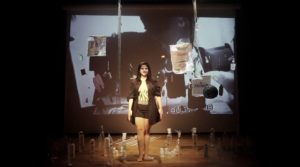The Ideas on Main Themes
Scene of Nuclear Waste
After watching the television series ‘Chernobyl’, my understanding of nuclear contamination has deepened significantly. However, there remains a widespread lack of awareness among many globally about the dual nature of nuclear energy as both a clean energy source and a producer of formidable pollution.
In our group’s initial discussion, we recognized the diverse strengths of each member and drafted a preliminary plan for the theme. To facilitate scene setting, prop creation, and atmosphere design, we unanimously agreed on creating an underwater scenario, allowing for greater creative expression in the visual direction. This decision naturally led to the incorporation of themes related to nuclear waste water discharge. As a topic, it doesn’t have to dominate the drama but can be integrated as one of its elements. For instance, it could depict marine life struggling to return home, hindered in the last leg of their journey by nuclear wastewater, or malformed creatures born in polluted seas attempting to escape.
The strength of this theme lies in its expressiveness, particularly in sound design. The natural terror evoked by the sound of a Geiger counter can be amplified through surround sound systems, offering the audience a more profound experience. Additionally, the use of fluorescent green props in a dark space can effectively immerse the audience in the environment.
Horror Scenes
Horror scenes inherently excel in their expression through sound and lighting design. The employment of a continuous low-frequency heartbeat, sudden noises, audio spatial changes, and processed human voices can adeptly sculpt the ambiance of a performance.
Similarly, lighting control offers a multitude of options, such as sudden flickering, cool-toned lighting, fluorescent-colored scenes, and the utilization of shadows and silhouettes. These elements synergistically contribute to the creation of a profoundly immersive and unsettling atmosphere characteristic of horror settings.
The Presentation Format of the Performance
Definition of Digital Media Performance
Traditional performance: A musical, dramatic, or other entertainment presented before an audience. Digital media performance includes virtual reality and robot performance work, telematic performances in which remote locations are linked in real time, Webcams, and online drama communities, and considers the “extratemporal” illusion created by some technological theater works.
Dixon, Steve. 2007. Digital Performance: A History of New Media in Theater, Dance, Performance Art, and Installation. Cambridge, MA: The MIT Press. https://doi.org/10.7551/mitpress/2429.001.0001.
Thoughts on Possible Format
An artistic performance can be crafted through the use of one or two backdrop curtains in combination with projected imagery. This can be complemented by handcrafted elements such as balloons, fish-shaped lanterns, or models to enhance the foreground of the stage. Simultaneously, controlled lighting or projectors from above can be synchronized with real-time audio and video animations to create an immersive atmosphere.

Possible Max Visual-Audio Solution

An example of stage arrangement consisting of a projector and foreground models
We have considered a multi-faceted approach for our stage setup, involving the use of multiple curtains, projectors, and meticulously crafted foreground models. Each scene, along with its corresponding foreground elements, is individually created and controlled by team members. The performance involves the synchronization of lighting, pre-recorded videos, sound effects, and live manipulation of foreground models, immersing the audience in various scenes and emotions. However, one drawback of this approach lies in the complexity of system setup, including sound arrangement, which can potentially lead to technical issues and synchronization challenges during live performances.
Another option I want to explore involves the use of one or two fixed screens for video projections. In this setup, some foreground models remain static while others can be interchanged during scene transitions or utilized as props by the performers. This approach offers the advantage of greater system control, reduced risk of technical glitches, and simplified synchronization of audio and visuals. It ensures a smoother and more reliable live performance experience, as sound and visuals do not interfere with each other.
These two approaches can be integrated with the previously mentioned audience-experience elements of “suspended balloons” and the pairing of light projectors, to enhance the overall effect of the live performance. Additionally, the music can be pre-arranged to include sections for expressive live instrumental performances, or to allocate certain rhythms for audience interaction, making the experience more engaging and dynamic.

